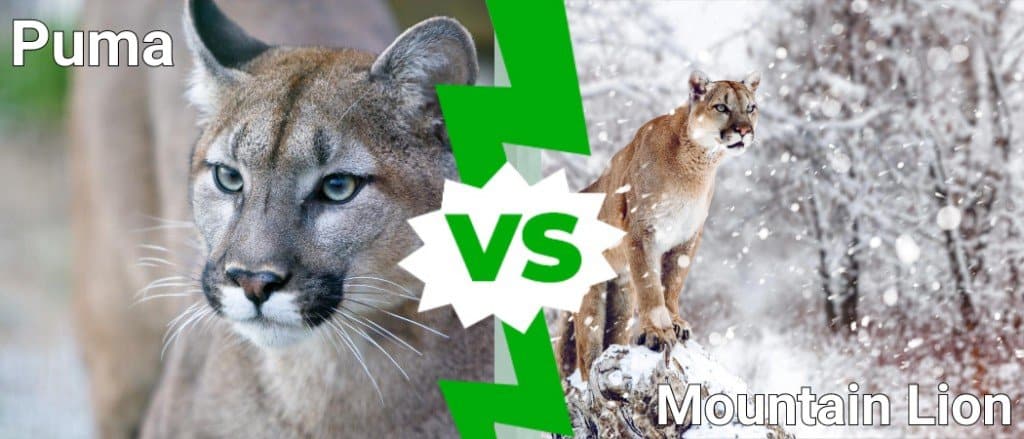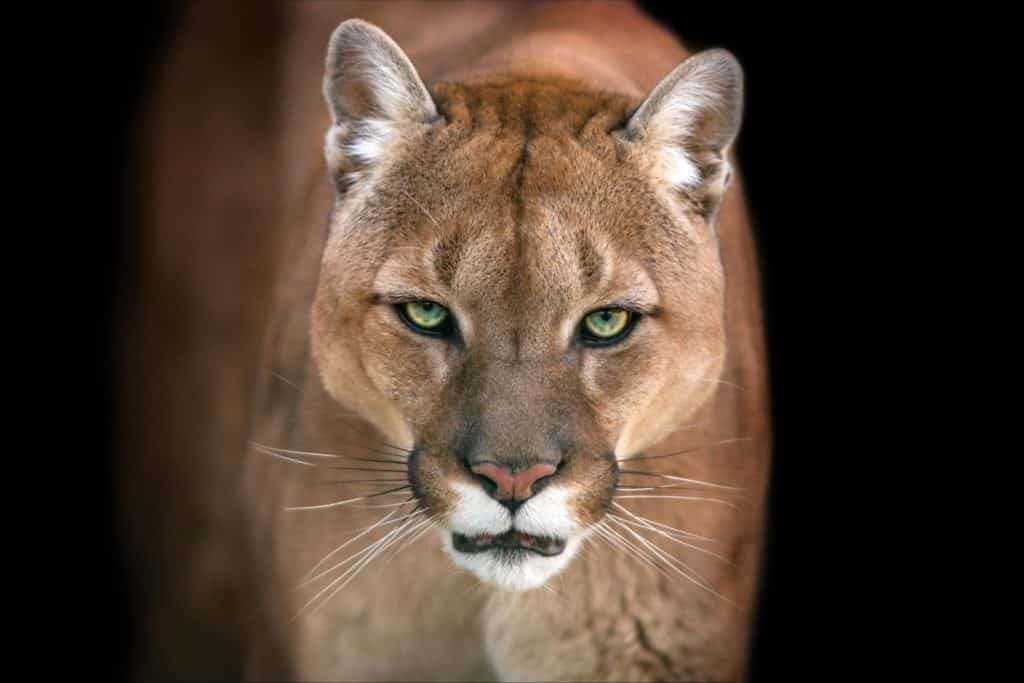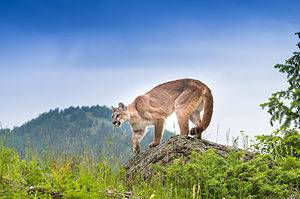You may not yet be aware of just how many names a puma can be called- and this includes comparing a puma vs mountain lion! Rest assured, a puma and mountain lion are indeed the same animal, but why are they called such different names? This is only where our names for puma begin, as there are quite a few synonyms used for this big cat.
In this article, we will address all of the different subspecies of pumas and mountain lions, including where they are commonly located. We will also address how you can identify one of these big cats in the wild, as well as where their preferred habitats are. Let’s get started and learn more now!
Comparing Puma vs Mountain Lion

| Puma | Mountain Lion | |
|---|---|---|
| Genus | Puma | Puma |
| Size | 5-8 feet; up to 180 pounds | 5-8 feet; up to 180 pounds |
| Appearance | Tan or yellow coat, rounded face and eyes. Pointed ears and extremely long tail | Tan or yellow coat, rounded face and eyes. Pointed ears and extremely long tail; coat may be longer in mountainous areas |
| Location and Habitat | Worldwide, depending on subspecies | Worldwide, depending on subspecies |
| Subspecies | Puma concolor anthonyi, Puma concolor cabrerae, Puma concolor concolor, Puma concolor costaricensis, Puma concolor couguar, Puma concolor puma | Same as puma, though will not contain low-lying subspecies of puma |
Key Differences Between Puma vs Mountain Lion

There are a few different subspecies of puma or mountain lion, depending on where these big cats are located.
©Kwadrat/Shutterstock.com
There is no difference between a puma vs mountain lion. These are simply two different names for the same animal. There are even more names when referring to a puma or mountain lion as well, such as cougar, catamount, painter, and panther. However, both the names lion and panther refer to entirely different species of big cats!
Let’s talk more about the puma or mountain lion in detail now.
Puma vs Mountain Lion: Family and Scientific Classification
Given that there is no difference between a puma vs mountain lion, let’s take a moment to discuss their subspecies. There are a few different subspecies of puma, depending on where these big cats are located. Some of these subspecies include Puma concolor anthonyi, Puma concolor cabrerae, Puma concolor concolor, Puma concolor costaricensis, Puma concolor couguar, Puma concolor puma.
However, as of 2017, only two species of cougar are recognized as valid. They include the puma concolor concolor located primarily in South America, and Puma concolor couguar located in North and Central America. However, the physical differences and hunting styles of these pumas do not differ much.

Pumas and mountain lions have the same physical appearance and size.
©Scott E Read/Shutterstock.com
Puma vs Mountain Lion: Physical Appearance and Size
Pumas and mountain lions have the same physical appearance and size. There is a size difference between male and female pumas, with male cats growing larger overall. A puma or mountain lion can reach 5-8 feet long and up to 180 pounds, depending on gender. This length includes their extremely long tail as well.
The mountain lion is easily recognized for its long tail and tan coat. These big cats have darker markings around their eyes, and the end of their tail is also black. Their coats are streamlined and smooth, though some mountain dwelling pumas may have thicker coats to withstand cooler temperatures.

The mountain lion or puma is easily recognized for its long tail and tan coat.
©Christina Moraes/Shutterstock.com
Puma vs Mountain Lion: Behavior and Diet
The diet and behavior between pumas and mountain lions often overlaps, especially when you consider that these two animals are the same. Pumas and mountain lions eat rodents, rabbits, birds, deer, and livestock in more populated locations. They rarely attack humans, but can do so if their food sources are threatened.
Mountain lions and pumas are well known for their ability to silently stalk their prey. You may not even know if a puma is following you, which is why it is always important to pay attention if you happen to be hiking in an area where pumas are present!

Pumas and mountain lions eat rodents, rabbits, birds, deer, and livestock in more populated locations.
©S.R. Maglione/Shutterstock.com
Puma vs Mountain Lion: Preferred Habitat and Geographic Location
A puma or mountain lion is an extremely adaptable creature. They live in a wide variety of regions, habitats, and geographical locations. These big cats are located around the world, in all environments besides Antarctica or other extremely cold locations. Let’s talk more about what they need in their habitat in order to feel comfortable, and if there are any differences between pumas depending on their geographic locations.
Mountain lions are found throughout the western United States, and a small amount in Florida in particular. Besides North America, you can find pumas in jungles, forests, grasslands, and rocky, mountainous areas. They enjoy relative secrecy and solitude, which is why you likely won’t see one in the wild unless it wants you to see it. These big cats prefer locations that feel protected, and they can even survive in warm, humid jungles.
The photo featured at the top of this post is © Scott E Read/Shutterstock.com
Thank you for reading! Have some feedback for us? Contact the AZ Animals editorial team.






